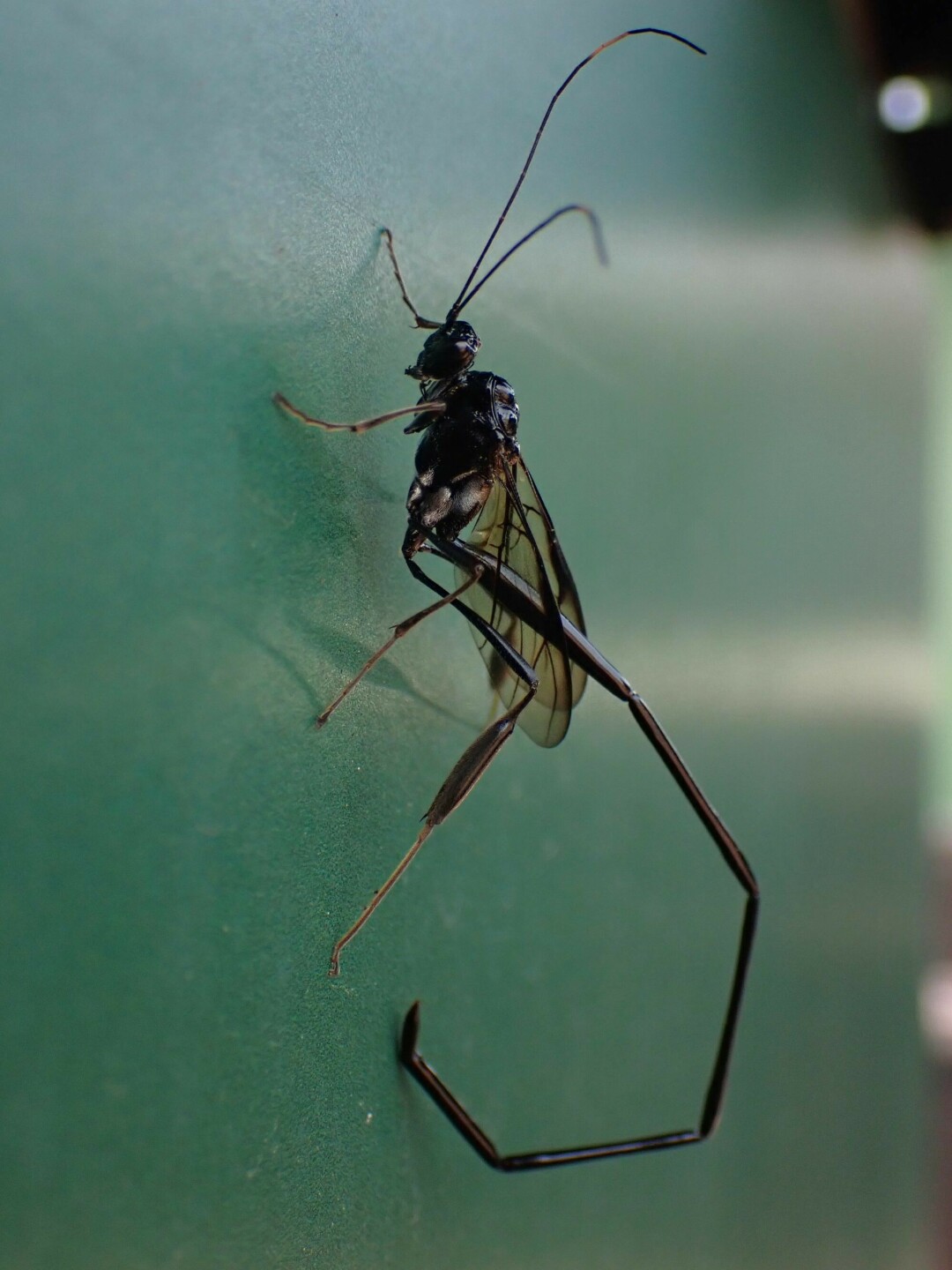News & Articles
Browse all content by date.
 The American Pelecinid Wasp has a scary-looking tail that won’t sting you. Only the larvae of Junebugs need be afraid. Photo by Emily Stone.
The American Pelecinid Wasp has a scary-looking tail that won’t sting you. Only the larvae of Junebugs need be afraid. Photo by Emily Stone.
“Check out this insect!” called our intern Kali from their desk in the Museum’s back office. On the outside of the window was a lanky black critter. Two long forked antennae, six long legs, smoky wings, and a long, jointed, curving abdomen all attached to a smallish head and thorax. Recognizing the creature as a wasp, and long tail as a modified abdomen become egg-squirting ovipositor, we all agreed that she looked like an ichneumon wasp.
Ichneumon wasps don’t sting, and feed only on nectar and water as adults, but the feeding habits of their larvae are more shocking. That long ovipositor allows the adult female to drill through soil, wood, and the skin of the larvae of other creatures and deposit the wasp egg in another mother’s larva. Then the wasp larva eats the other larva, sometimes quickly, and sometimes living with them while the food source grows and develops. The end result is the same, though: a grown-up wasp and an eaten-up host. Because the wasps have a close relationship with their host, but end up killing them, they are known as parasitoids.
Ichneumon wasps are incredibly diverse, and host-specific, with a particular species of wasp focusing on a particular species or genus of host insect. And, while their lifestyle may make us squeamish, they are incredibly important for keeping pest species in check and encouraging balance in our ecosystems. A few days later, while eating ice cream at a rest area, I spotted another of these lanky, black wasps on the roof rack of my car. She flew off before I could get a photo. But, when I stopped to get gas, there was one just sitting on the vertical surface of the pump, at about knee height. This time I snapped a photo before she flew away. Having seen this same critter three times in as many days, I was keen to look them up and get an official identification on this neat wasp.
To my surprise, iNaturalist informed me that this was not an ichneumon at all! Pelecinid wasps are similar to ichneumon wasps in that adults drink nectar, and they have long ovipositors for depositing eggs directly in the larva of another species. They just happen to be in their own family – Pelecinidae. And, while scientists estimate that there might be 100,000 species of ichneumon wasps worldwide, the Pelecinidae family contains only three species, with only one occurring north of Mexico. This was it: Pelecinus polyturator, the American Pelecinid Wasp. Like all of our favorite parasitoid wasps, these help control one specific pest species: Junebugs. I can remember many summer nights when those huge brown beetles would buzz against our window screens in the dark and scare me into thinking that a monster was trying to get into the house.
That’s not why most people are annoyed at Junebugs, though. The larvae of Junebugs feed on plant roots for two years as they grow through three instars and become more damaging with each growth spurt. Larger trees can survive this damage, but the beetle larvae do kill small plants. Our non-native lawns can’t survive major infestations of these native larvae, and turfgrass sometimes dies, aided by the actions of skunks and raccoons who go digging for a juicy larval dinner. As Simba says, “Slimy, yet satisfying.”
We can cheer on the Pelecinid wasps, then, as the female drills her ovipositor up to two inches deep in the soil and deposits a wasp egg on a Junebug larva. The wasp larva hatches and starts munching. Some species of wasp larvae are precise eaters, and do their best to consume the inessential parts first so that their host stays alive and fresh for as long as possible. Pelecinid larvae don’t seem to mind an expired meal and just chomp right in. Once the food is gone, they pupate and emerge as adults in late summer.
Scientists aren’t sure how she finds the larvae, but the wasp’s activity period coincides with the season when Junebug larvae migrate closest to the soil surface. Parasitoid and host are closely tied. The most fascinating thing about Pelecinid wasps might not be their creepy feeding habits. Their mating system is wild, too!
In North America, almost all of them are female and reproduce by thelytokous parthenogenesis. Parthenogenesis means virgin birth. It describes reproduction from an unfertilized, haploid egg, and it usually produces males. Other wasps and bees do this to produce drones. In the Pelecinid’s version of parthenogenesis, eggs start off as diploid, and produce genetically identical females without fertilization. Strangely, it’s just our species of Pelecinids who do this. The two species of Pelecinids who live in Central and South America have the normal male/female ratio and relationships in their populations.
So, since I saw three of these lanky black wasps in as many days, I’m guessing they’re in your neighborhood, too. Let me know if you see one, especially if they have the short abdomen of a rare male. I love when nature gets weird!
Emily’s award-winning second book, Natural Connections: Dreaming of an Elfin Skimmer, is available to purchase at www.cablemuseum.org/books and at your local independent bookstore, too. For more than 50 years, the Cable Natural History Museum has served to connect you to the Northwoods. Our exhibit: “The Northwoods ROCKS!” is open through mid-March. Our Fall Calendar of Events is ready for registration! Follow us on Facebook, Instagram, YouTube, and cablemuseum.org to see what we are up to.
| Tweet |


